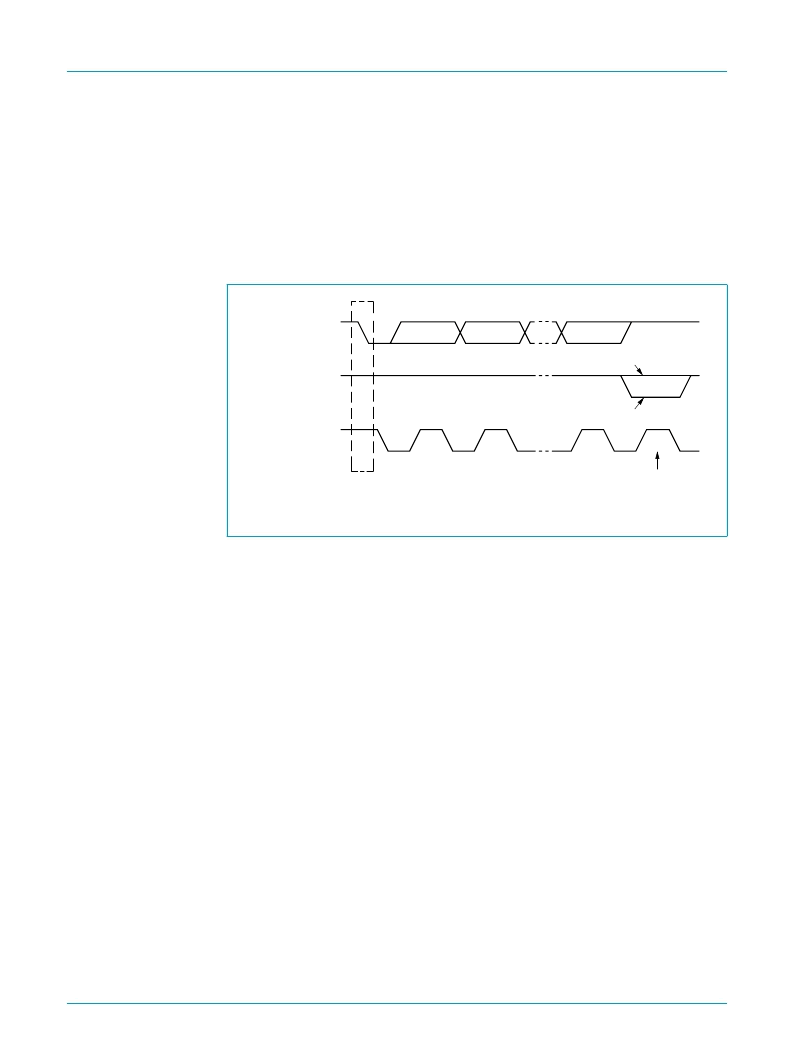- 您現(xiàn)在的位置:買(mǎi)賣IC網(wǎng) > PDF目錄382379 > PCD3316 (NXP Semiconductors N.V.) Caller-ID on Call Waiting CIDCW receiver PDF資料下載
參數(shù)資料
| 型號(hào): | PCD3316 |
| 廠商: | NXP Semiconductors N.V. |
| 英文描述: | Caller-ID on Call Waiting CIDCW receiver |
| 中文描述: | 來(lái)電呼叫等待CIDCW編號(hào)接收機(jī) |
| 文件頁(yè)數(shù): | 12/30頁(yè) |
| 文件大小: | 534K |
| 代理商: | PCD3316 |
第1頁(yè)第2頁(yè)第3頁(yè)第4頁(yè)第5頁(yè)第6頁(yè)第7頁(yè)第8頁(yè)第9頁(yè)第10頁(yè)第11頁(yè)當(dāng)前第12頁(yè)第13頁(yè)第14頁(yè)第15頁(yè)第16頁(yè)第17頁(yè)第18頁(yè)第19頁(yè)第20頁(yè)第21頁(yè)第22頁(yè)第23頁(yè)第24頁(yè)第25頁(yè)第26頁(yè)第27頁(yè)第28頁(yè)第29頁(yè)第30頁(yè)

Philips Semiconductors
PCD3316
CIDCW receiver
Product specification
11 March 1999
12 of 30
9397 750 04824
Philips Electronics N.V. 1999. All rights reserved.
Unetited
The device that acknowledges must pull down the SDA line during the acknowledge
clock period immediately after the 8th SCL pulse, so that the SDA line is stable LOW
times must be taken into consideration).
A master receiver must signal an end of data to the transmitter by not generating an
acknowledge on the last byte that has been clocked out of the slave. In this event the
transmitter must leave the data line HIGH to enable the master to generate a STOP
condition.
7.12.5
I
2
C-bus protocol
Before any data is transmitted on the I
2
C-bus, the device which should respond is
addressed first. The addressing is always carried out with first byte transmitted after
the START procedure. One I
2
C-bus slave address is reserved for the PCD3316, E0H
(1110 0000 for write and 1110 0001 for read).
The I
2
C-bus protocol is shown in
Figure 13
. Two different sequences are considered,
the write sequence and the read sequence. Both sequences are initiated with a
START condition (S) from the I
2
C-bus master which is followed by the PCD3316 slave
address with the read bit cleared. The first byte after the I
2
C-bus address is
interpreted as the address of a PCD3316 register.During the write sequence the
register address of the PCD3316 is auto-incremented on each acknowledge. The
write sequence is ended with a STOP condition from the master. If the addressed
register is read-only or non-existent, nothing will be changed.
For the read sequence the bus master issues a repeated START condition followed
by the PCD3316 slave address with the read bit set. Then data is read from
previously set address and sent out. When the master responds with an acknowledge
the address of the register is auto incremented and the slave will put the data from
the next register on the bus. The read sequence is stopped when the master stops
giving an acknowledge and generates a STOP condition.
When a non-existing register is addressed the PCD3316 will return FFH. Existing
register addresses are shown in
Section 7.13
. An additional register address (73H) is
reserved for test purposes. This address cannot be reached with the auto-increment
function of the I
2
C-bus interface.
Fig 12. I
2
C-bus acknowledge.
idth
MBC602
S
START
condition
9
8
2
1
clock pulse for
acknowledgement
not acknowledge
acknowledge
DATA OUTPUT
BY TRANSMITTER
DATA OUTPUT
BY RECEIVER
SCL FROM
MASTER
相關(guān)PDF資料 |
PDF描述 |
|---|---|
| PCD3316T | Caller-ID on Call Waiting CIDCW receiver |
| PCD3330-1 | Multistandard repertory dialler/ringer with EEPROM |
| PCD3330-1P | Multistandard repertory dialler/ringer with EEPROM |
| PCD3330-1T | Multistandard repertory dialler/ringer with EEPROM |
| PCD3354AH | 8-bit microcontrollers with DTMF generator and 256 bytes EEPROM |
相關(guān)代理商/技術(shù)參數(shù) |
參數(shù)描述 |
|---|---|
| PCD3316T | 制造商:PHILIPS 制造商全稱:NXP Semiconductors 功能描述:Caller-ID on Call Waiting CIDCW receiver |
| PCD3316TD-T | 制造商:未知廠家 制造商全稱:未知廠家 功能描述:Caller Number ID Circuit |
| PCD3320CD | 制造商:未知廠家 制造商全稱:未知廠家 功能描述:Pulse Telephone Dialer |
| PCD3321CD | 制造商:未知廠家 制造商全稱:未知廠家 功能描述:Pulse Telephone Dialer |
| PCD3322CP | 制造商:未知廠家 制造商全稱:未知廠家 功能描述:Pulse Telephone Dialer |
發(fā)布緊急采購(gòu),3分鐘左右您將得到回復(fù)。